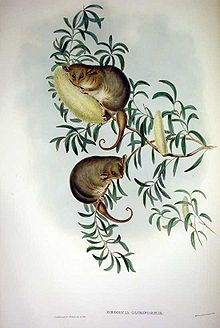Burramyidae
| Pygmy possums Temporal range: Pleistocene–Recent |
|
|---|---|
 |
|
| Eastern pygmy possum (Cercartetus nanus) | |
| Scientific classification | |
| Kingdom: | Animalia |
| Phylum: | Chordata |
| Class: | Mammalia |
| Infraclass: | Marsupialia |
| Order: | Diprotodontia |
| Superfamily: | Phalangeroidea |
| Family: |
Burramyidae Broom, 1898 |
| Genera | |
The pygmy possums are a family of small possums that together form the marsupial family Burramyidae. The five extant species of pygmy possum are grouped into two genera. Four of the species are endemic to Australia, with one species also co-occurring in Papua New Guinea and Indonesia.
Pygmy possums range in length from about 5 to 12 cm (2.0 to 4.7 in), and usually weigh between 10 and 50 grams (0.35 and 1.76 oz). They are nocturnal and omnivorous, living on a diet of invertebrates, fruit, seed, nectar and pollen. They are excellent climbers, due in part to their prehensile tails. Although they cannot glide like some other species of possums, some species are able to leap long distances.
Conservation International (CI) and the Indonesia Institute of Science (LIPI) reported on the possible discovery of a new species of Cercartetus pygmy possum upon visit to the Foja Mountains in June 2007.
The two genera of pygmy possums are Burramys and Cercartetus. Burramys contains only one extant species, the mountain pygmy possum, B. parvus. As currently understood, Cercartetus consists of four extant species.
† = extinct species
...
Wikipedia
